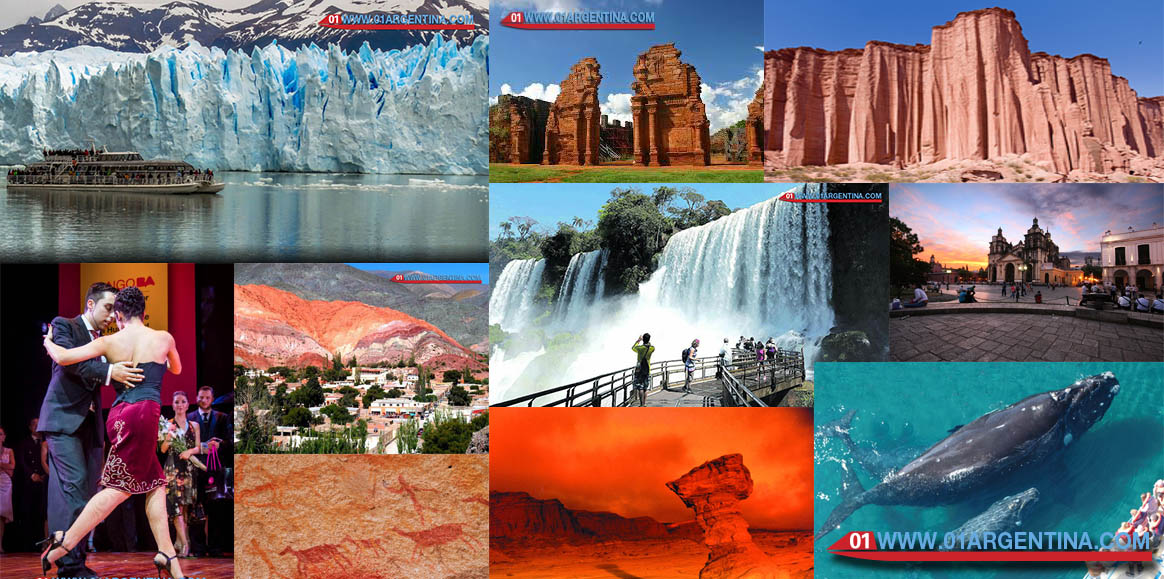
In Argentina there are 8 natural and cultural areas of unique features that were declared by UNESCO World Heritage. The first of the sites that received recognition of World Heritage was the Los Glaciares National Park in the province of Santa Cruz, in 1981. Among the most recent is the Tango.
Today we tell you what are sorted by province:
Misiones
Ruins of the Jesuit Missions Guarani are 296 kilometers on the banks of the Parana River encompassing the ruins of San Ignacio Mini, Loreto, Santa Ana and Santa Maria. According to UNESCO, as a whole “they represent a sociocultural unprecedented in the history of peoples and economic experience.” The reductions established in the first half of the seventeenth century, were among the 33 people who made up the former Jesuit Province of Paraguay.
Iguazu Falls in its namesake park not only declared a World Heritage Site for its beauty and great biodiversity but also elected as one of the Seven Wonders of the World. The park is located within a large subtropical jungle and covers some 67,000 hectares. There, the Iguazu River is the main arm of water that feeds more than 250 jumps.
Jujuy
La Quebrada de Humahuaca, a vast valley that extends for 170 kilometers, between 2000 and 4000 meters of altitude above sea level. Located less than an hour’s drive from San Salvador de Jujuy (provincial capital), cultural and archaeological route passes through small mountain villages with adobe houses, ancient churches and ruins of fortresses that stand the test of thousands of years history. Among the major attractions are Purmamarca and its Cerro de los Siete Colores, whose layers reflect different geological ages; It Maimará and “The Painter’s Palette”; Pucara de Tilcara, a fortified town built by natives omaguacas; the monolith marks the Tropic of Capricorn, where each June 21st marks the Inti Raymi (Festival of the Sun); and Humahuaca, founded by the Spaniards in the late sixteenth century.
Cuyo (San Juan and La Rioja)
In the border of the provinces of San Juan and La Rioja are the Ischigualasto Provincial Park and Talampaya National Park. The most important value of these areas is preserved fossil remains, considered among the most complete that are known from the Triassic Period, 200 million years ago.
Ischigualasto (San Juan), popularly known as Moon Valley, is a major paleontological sites in the world, where the remains of vertebrates that inhabited the place, traces of footprints of dinosaurs and petrified araucarias trunks are sighted. Access to the park is exclusively land, the route is guided and extends between 3 and 4 hours.
Talampaya (La Rioja) stands out for its strong orographic contrasts that make white deserts, embankments and extravagant ways stony reddish carved by erosion from wind and water. The tours visit Murallón with remains of mortars dug in the rock and figures such as the fireplace, Three Kings, The Cathedral and Monk; Drawers; and the Lost City, which is accessed from a viewpoint to a kind of crater.
Cordoba
The Jesuit Block and the Way of the units that belonged to the Society of Jesus.
In the Way of the Jesuit stays include Jesús María, Caroya, Santa Catalina, La Candelaria and Altagracia. The route stretches for about 250 kilometers of hills and custody works conducted by missionaries and built by the Indians who inhabited the area in the early seventeenth century. They cultivated the land and raised cattle.
The Jesuit Block, located in the city of Cordoba Capital, focuses on a single block the Church of the Society of Jesus, the Domestic Chapel, the residence of the Jesuits and the Rector of the National University of Córdoba, old Maximum School of Mission.
Chubut
Valdes Peninsula, a few kilometers from the city of Puerto Madryn. About 400 thousand hectares of land and 176,000 other sea on the Atlantic Ocean, where there is a biodiversity unique in the world. The itinerary includes beaches and cliffs of great geological, caves, mountain biking, sailing, diving and kayaking. One of the main attractions is the marine fauna, with a population ranging from whales to Magallanes penguins are sighted between June and December.
Santa Cruz
Cave of the Hands, site of great archaeological and paleontological significance, whose hands and animal figures are considered the oldest expressions of the South American peoples. Paintings located on the river near the town of Perito Moreno, the cave is 170 meters deep and maintains more than 10,000 years of history.
Los Glaciares National Park, about 700 thousand hectares for the preservation of a vast area of continental ice and glaciers over 40 southern Andean-Patagonian forest. Inside it is one of the tourist destinations most visited by foreigners: the Perito Moreno Glacier, about 78 kilometers from El Calafate, recognized by the phenomenon of break starring in three or four years.
Buenos Aires
The tango, a musical genre and a popular dance that has its roots in Buenos Aires (Capital Federal), during the last decades of the nineteenth century, and surprises today in every corner of Buenos Aires. With great influence of European immigration, he managed Tango become a true cultural identity. Cultural centers, ancient halls, cafes and clubs are home at night some tango proposal. There milongas, open-air exhibitions and dinner with show included.










